Explore the Diverse Types of Salmon Varieties of British Columbia
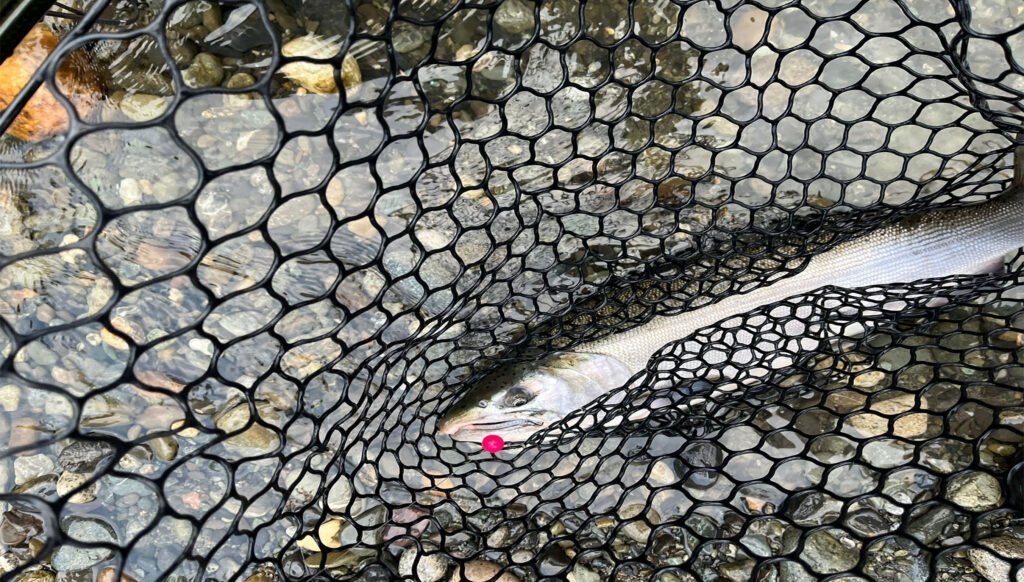
B.C. is home to many types of salmon. Imagine standing by a B.C. river, watching fish swim upstream. This is where the magic starts. It connects ecosystems, cultures, and generations. In North America, five Pacific salmon species thrive here: Chinook, coho, chum, sockeye, and pink1.
Their scientific name, Oncorhynchus, tells their story. It comes from Greek words for “hook” and “nose,” describing the males’ fierce kype1.
British Columbia’s waters are home to over 9,000 salmon populations. They are grouped into 450 conservation units to keep their balance1. These salmon shape our landscapes, feeding forests and waters. Their life cycle is unique, giving freshwater ecosystems a nutrient-rich gift1.
From Indigenous traditions to modern fisheries, salmon are part of our heritage. Whether you fish, cook, or care for the environment, knowing about B.C.’s salmon is key. At BeadnFloat, we support ethical fishing with our soft beads. Let’s celebrate these salmon and their importance in the Pacific’s ecosystem.
The Rich Salmon Heritage of British Columbia Waters
British Columbia’s waters are home to many salmon species. This makes it key to coastal ecosystems and culture. The province’s cold rivers and ocean currents are perfect for salmon to grow and spawn.
Over 9,000 salmon populations are found here, divided into 450 conservation units2. These waters have supported communities and economies for many years.
Why BC is the Premier Salmon Destination in Canada
BC’s geography is great for salmon. The Fraser River has one of the biggest sockeye salmon runs. This is important for wildlife and fisheries3.
Salmon like chinook, coho, and sockeye do well here. Clean streams and productive marine zones help them thrive. This supports Indigenous traditions and modern fishing2.
The Cultural Significance of Salmon to Indigenous Communities
Salmon mean a lot to Indigenous cultures. They symbolize resilience and care for the land. For thousands of years, First Nations have harvested salmon sustainably.
They use salmon in art, ceremonies, and food. Their knowledge helps keep the balance between people and nature. This way, salmon are preserved for the future3.
How Salmon Shaped BC’s Fishing Industry
Salmon fishing helped build BC’s coastal economy. From old canneries to today’s eco-friendly practices, the industry has evolved. Companies like BeadnFloat use gear that’s good for the environment.
Even with more farmed salmon, wild stocks are important. In 2013, British Columbia made Pacific salmon its official fish3.
Types of Salmon Found in British Columbia’s Waters
British Columbia’s waters are home to five native Pacific salmon species. Each has its own unique traits. These fish migrate from freshwater to the ocean, growing before they return to spawn. While wild salmon include Chinook, coho, sockeye, pink, and chum, types of farmed salmon in BC are mostly Atlantic, not native Pacific species4.
- Chinook (King): Oncorhynchus tshawytscha) — The largest species, reaching 30+ pounds5, with rich, firm flesh ideal for grilling6. Popular among anglers for their size and flavor.
- Coho (Silver: Oncorhynchus kisutch) — Weighing 4–12 lbs6, their vibrant orange flesh suits grilling and sautéing6. Their strong fights make them a popular salmon varieties for sport fishing.
- Sockeye (Red: Oncorryhynchus nerka) — Known for deep red flesh6, sockeye average 6 lbs6 and thrive in clean streams. Habitat challenges like the 2019 Big Bar landslide have impacted populations4.
- Pink (Humpy: Oncorryhynchus gorbuscha) — The smallest Pacific salmon, weighing 4 lbs6, they’re vital for ecosystems and canneries5.
- Chum (Dog: Oncorhynchus keta) — Favored for their tough fights5, chum salmon offer firm texture and mild flavor6.
Most types of farmed salmon in BC are Atlantic salmon, raised in open-net pens or land-based farms4. Wild species like Chinook and sockeye remain popular salmon varieties for both chefs and anglers. For ethical angling, BeadnFloat’s soft beads match the preferences of each species, ensuring sustainable practices.
Atlantic salmon farming dominates B.C. aquaculture, but wild Pacific species define our coastal ecosystems.
Understanding these popular salmon varieties helps anglers choose baits like BeadnFloat’s soft beads. These are designed to target species-specific behaviors without harming habitats.
The Pacific Salmon Species: Identification Guide
Learning about British Columbia’s salmon starts with their unique features. This guide helps you identify the different types of Pacific salmon found here. It’s great for both anglers and visitors.
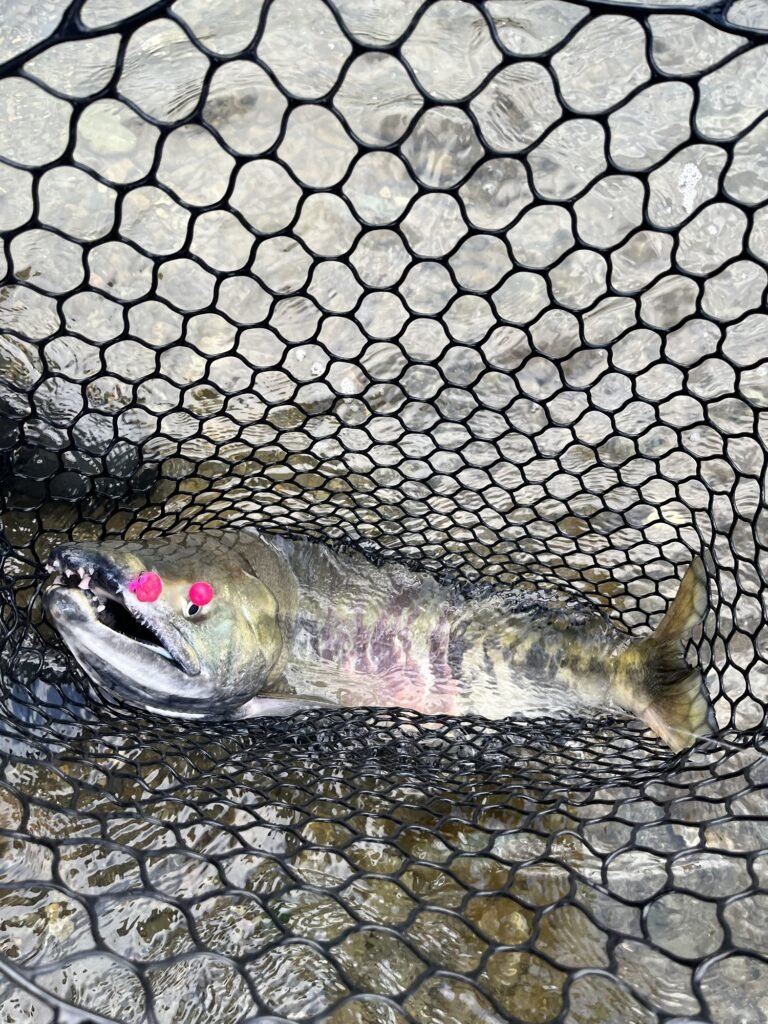
Chinook (King) Salmon: The Prized Catch
- Dark metallic scales with black gums and large spots on back and tail7
- Can grow up to 50kg and travel 1,500 km inland6
- Use BeadnFloat 16mm-19mm beads for their size and strength
Sockeye Salmon: The Vibrant Red Delicacy
- Has a white gum line and bright red colour with no tail spots7
- Spends 4-5 years at sea before returning to freshwater6
- Pair with 12mm-16mm beads for optimal visibility
Coho (Silver) Salmon: The Sporty Fighter
- Has a white mouth with sharp teeth and spots on upper body7
- Spends 3 years at sea before returning to spawn in fast water6
- Match with 12mm-16mm beads for their energetic strikes
Pink Salmon: The Abundant Humpy
- Is the smallest species with large oval tail spots7
- Spawns in biennial runs, often in dense schools6
- Choose 6-8mm beads for their size and movement patterns
Chum Salmon: The Underrated Powerhouse
- Has vertical red stripes and a white anal fin tip during spawning7
- Migrates up to 150 km inland before spawning6
- Optimal with 10mm-14mm beads for their fighting style
Knowing these salmon variations helps anglers pick the right gear. Our BeadnFloat beads are designed to match each species’ behavior. This makes identification and catching easier.
Seasonal Salmon Fishing Opportunities in British Columbia
British Columbia is a great place for fishing salmon all year. Each season brings its own special fish and places to catch them. Let’s look at when and where to find these amazing fish.
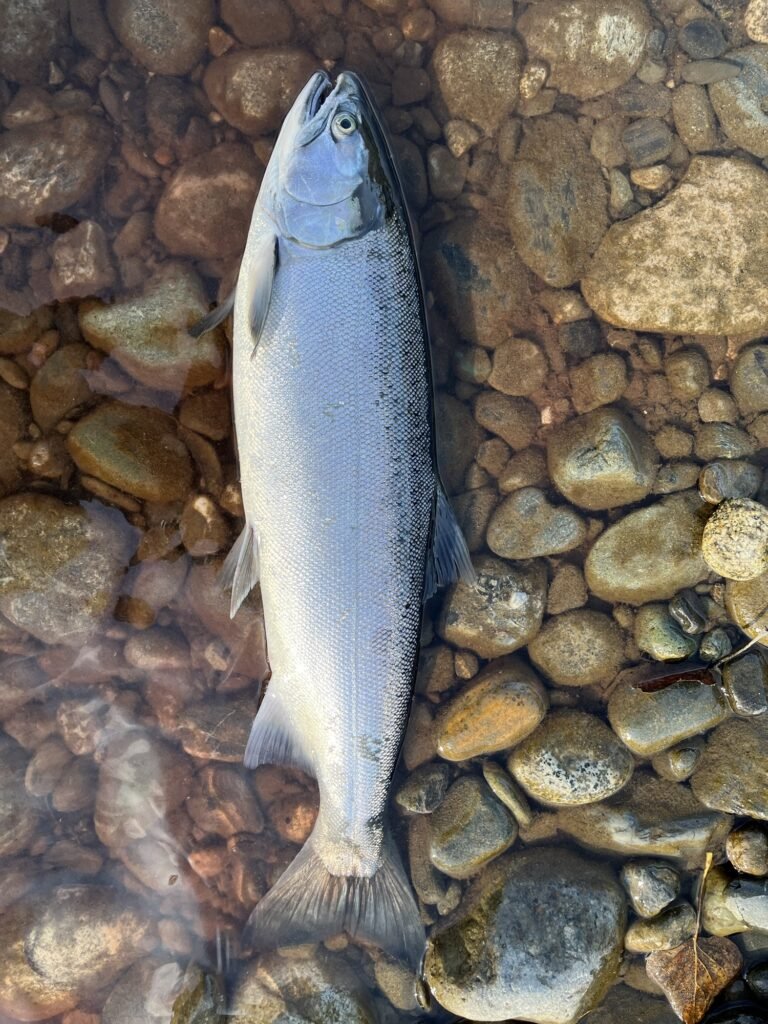
- Spring (April–May): Look for Chinook salmon weighing 10–30 lbs in the Gulf Islands or near the “Hump” off South Bowen. Use 6mm–8mm BeadnFloat beads to mimic small baitfish8.
- Summer (June–August): Go after sockeye (6–10 lbs) and Chinook (up to 32 inches) in river mouths. Try 10mm–12mm beads for their bright, flashy patterns6.
- Fall (September–October): Fish for Coho near the Capilano River and late Chinook. Opt for 14mm–16mm beads to match their larger prey8.
- Winter (November–April): Target feeder Chinook in coastal waters. Use 19mm beads for visibility in murky winter waters6.
Salmon migration is amazing, traveling up to 1,500 km inland. They use their sense of smell to guide them6. Their journeys are like running a marathon every day for 3,000 km8! BeadnFloat beads match these migrations: smaller sizes for spring smolts, larger ones as salmon grow. Anglers using our 6mm–19mm range align with nature’s cycle, boosting catch rates year-round.
Wild vs. Farmed: Understanding BC’s Salmon Production
British Columbia balances wild salmon fishing and aquaculture. Each has its own effects. Knowing these differences helps us make choices that help conservation.
The Environmental Impact of Salmon Farming
Farmed salmon operations challenge wild species like sockeye and coho. Hatcheries help rebuild stocks but need careful management to avoid genetic issues. In BC, farmed salmon are raised in net pens at high densities9.
Innovations like closed containment systems aim to lessen environmental harm10. Over 86% of B.C. residents are concerned about wild salmon decline. Yet, hatcheries produce 86,000 tonnes of farmed salmon each year, using little coastal space10.
How to Identify Wild-Caught vs. Farmed Salmon
Wild salmon species have varied colors and fat levels. Farmed salmon often have a consistent orange color from their diet. Look for MSC or Ocean Wise certifications to ensure sustainable choices.
Key differences include:
- Wild salmon: Naturally varied fat patterns
- Farmed salmon: Uniform marbling and higher omega-3 content9
- Nutrition labels: Both types offer similar health benefits9
The BeadnFloat Advantage: Using Soft Beads for Ethical Fishing
We suggest BeadnFloat’s soft beads for ethical fishing. They match the natural prey sizes for BC salmon types:
- 6-10mm beads for pink and small coho salmon
- 12-14mm for sockeye and mature coho
- 16-19mm for chinook and chum species
These beads help reduce injury in catch-and-release fishing. They support conservation efforts for all salmon species10. Choosing the right bead size ensures minimal ecological impact while targeting specific salmon types effectively.
Conclusion: Preserving British Columbia’s Salmon Legacy for Future Generations
Salmon are key to British Columbia’s nature and culture. They help keep freshwater systems healthy after they spawn. Sadly, over 142 wild salmon stocks have disappeared in BC, with 620 more at risk11.
Urban growth has destroyed 48 of Vancouver’s original 50 salmon streams. This shows how much humans have harmed nature11. Saving popular salmon types like sockeye and coho is urgent.
The Wild Salmon Policy aims to keep salmon safe in changing climates12. But, lack of funding and weak laws make habitats at risk11. Using soft beads for catch-and-release fishing helps. Also, restoring streams and supporting First Nations’ care for nature is important12.
Only a tiny fraction of salmon eggs grow into adults. So, every effort to save them is vital11. We must push for better laws, more money, and kinder fishing ways. Saving salmon is about keeping BC’s nature and culture alive for future generations.
Source Links
- https://psf.ca/learn/salmon-facts/
- https://www.bcsalmon.ca/faqs-media
- https://opentextbc.ca/geography/chapter/case-study-2-4/
- https://griegseafood.com/bc-wild-pacific-salmon
- https://absolutesportfishing.ca/bc-salmon-species/
- https://www.bcsalmon.ca/five-species
- https://www.ourwildpugetsound.com/journal/how-to-identify-pacific-salmon-in-puget-sound
- https://www.vancouversalmonfishing.ca/seasons-and-salmon-species/
- https://letstalkscience.ca/educational-resources/stem-explained/farmed-salmon-vs-wild-salmon
- https://www.bcsalmonfarmers.ca/farmed-and-wild-salmon/
- https://davidsuzuki.org/wp-content/uploads/2019/02/will-to-protect-preserving-b.c.s-wild-salmon-habitat.pdf
- https://www.pac.dfo-mpo.gc.ca/fm-gp/salmon-saumon/wsp-pss/policy-politique-eng.html


Add comment